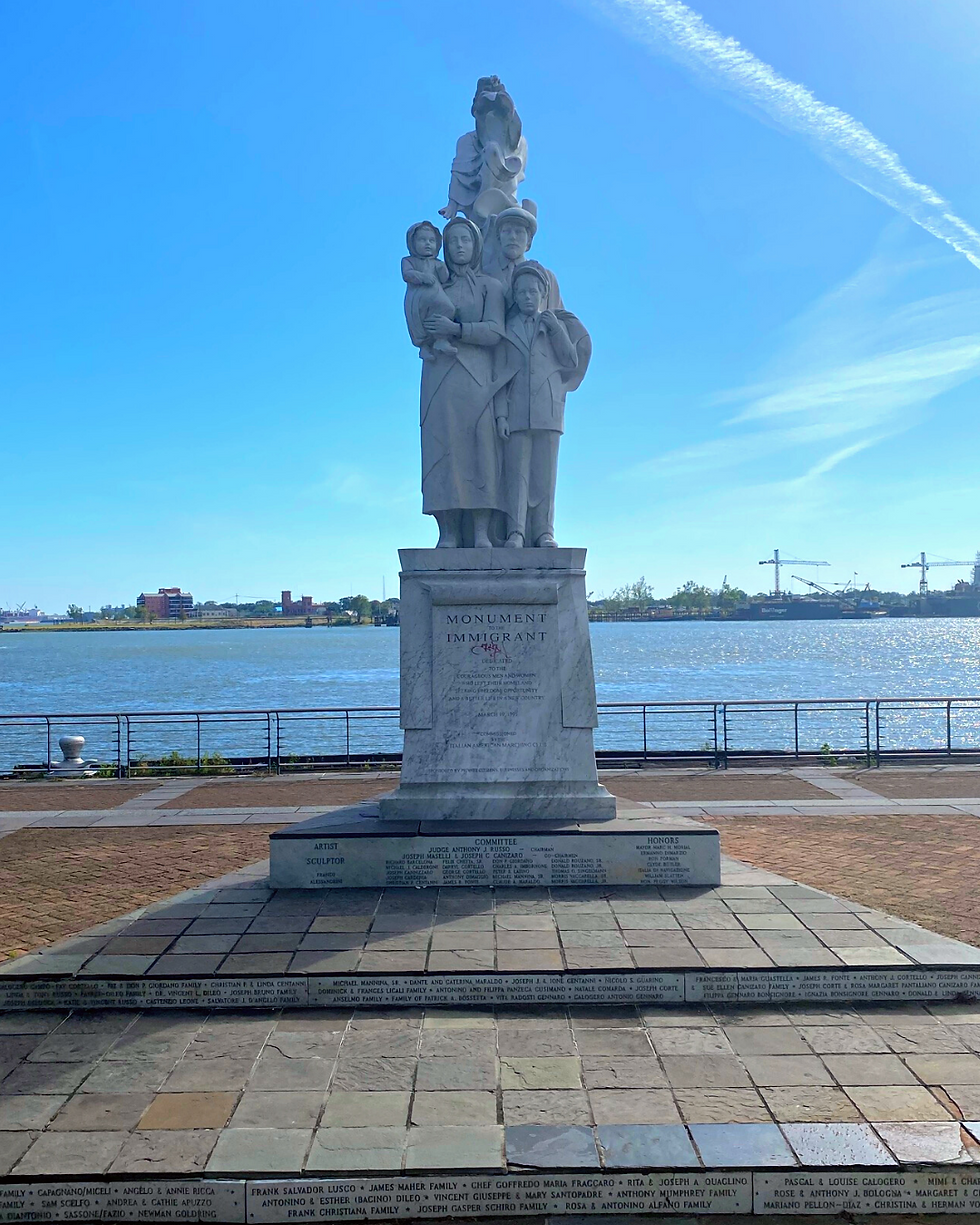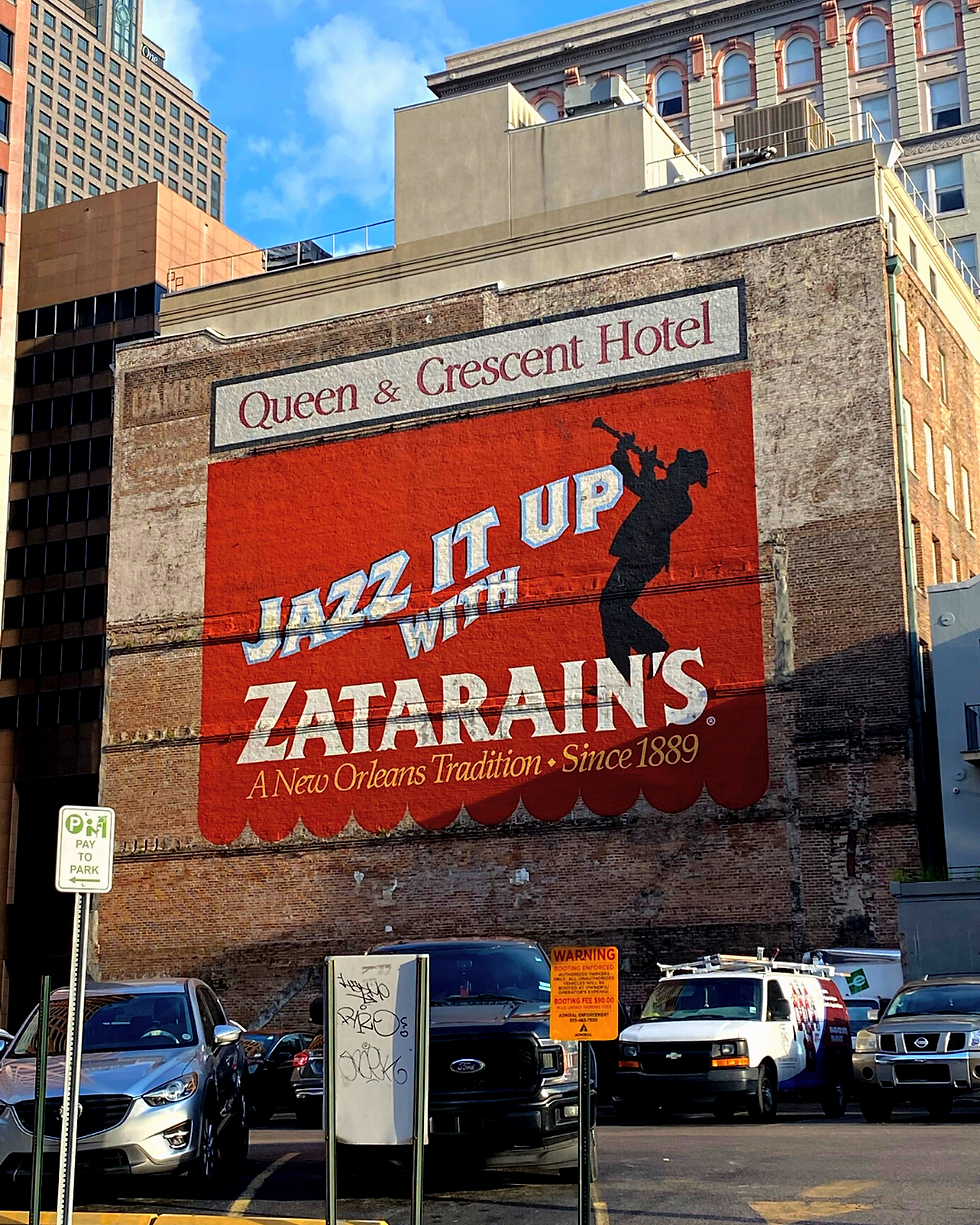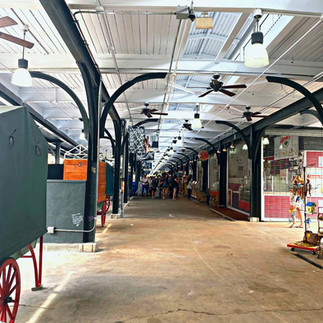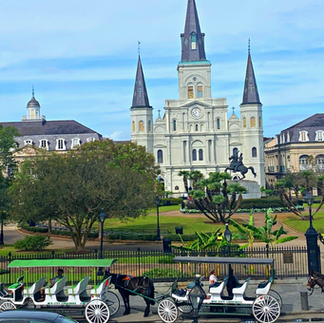3 Days in NOLA: Bourbon St to the Bayou
- Jeanne
- Dec 19, 2021
- 14 min read
Updated: Apr 10, 2022
New Orleans, Louisiana
Fall 2021 (3 Days)
Welcome back to 3WishesTravel Blog! We are exploring domestic locations throughout the United States and the territories this year. This post will focus on New Orleans, Louisiana, or NOLA, a culture-filled destination on the Gulf of Mexico. The "Big Easy" has everything to offer from museums to world-famous bars.
Check out our New Orleans Bayou: A Day with the Alligators post and stay tuned for our Traveling Jewish: NOLA post and Cuisine of New Orleans post! Remember to like us on Facebook and follow @3WishesTravel on Instagram for updates! Also, check out the new sections of the website, including Upcoming Trips and interactive maps of Countries and States I have visited. Now let's fly to New Orleans! 🧞♀️💜✈️
Table of Contents
Hotel and Flight Info 🏨✈️
I spent 3 days and 3 nights in New Orleans and was able to see everything from alligators to voodoo antiques. My flight was from Harrisburg International Airport (MDT) to Louis Armstrong New Orleans International Airport (MSY) which costs an average of $300 roundtrip ✈️.

I loved using either Airbnb.com or Hotwire.com to find great deals on accommodation. It can be more affordable to stay at either an Airbnb or hotel, it just depends on timing, season, and location, and the requirements of your stay. If you are interested in New Orleans's nightlife or French Quarter, I would recommend staying near Bourbon Street. If you want a less touristy vibe, check out Lower Garden District for a more upscale experience or the artsy Bywater area.
For a group of up to 4, Airbnb stays in New Orleans average $100-170 per night, with Bywater and Lower Garden District being slightly more affordable than staying in the French Quarter and on Bourbon Street. Although I chose a hotel for this trip, I have also found some beautiful, fresh, reliable, and affordable Airbnbs in the French Quarter, Lower Garden District, and Bywater areas that I would definitely check out.
Hotels will be around the same price, depending on location and time of the week, averaging $100-200 per night. For my trip, during the week in the Fall, I stayed on Bourbon Street at the Astor Crowne Plaza New Orleans for ~$140 a night.

Originally, the spot the Astor Crowne sits on, the 700 block of Canal St, was the site of the first non-Roman Catholic Church in the area built-in 1816. By 1845, the church outgrew the building and sold to philanthropist Judah Touro who created the Congregation Dispersed of Judah synagogue. After fires and a demolishing, the building was completely recreated in the 1950s. It would serve as a department store until the 2000s when it became the hotel that is today the Astor Crown Plaza. Source: Nola.com
If you plan to spend most of your time in the French Quarter and surrounding neighborhoods of New Orleans, I do not think it is necessary to rent a car. Getting from the airport to those neighborhoods can be done via taxi or public bus, although the public bus is not very frequent. Even if you are interested in the Bayou outside of the city, many tours provide transportation from the city. The #3WishesTravel🧞♀️💜✈️ estimate for a 4 day, 3 nights trip to New Orleans is...
Flight + Hotel : 4 days & 3 nights = $500 - 750
Short Note on Airport Codes!✈️
Both of the airports I used to get to New Orleans, MDT and MSY, are examples of airport codes being totally different from the name of the airport. Unlike airports like John F. Kennedy International Airport (JFK) and Philadelphia International Airport (PHL), MDT and MSY include letters not even found in the airport name. Let #world-famous3WishesTravel explain! Harrisburg International Airport's airport code is MDT because Harrisburg, PA's airport is actually located in a nearby city, Middletown, PA. MDT for Middletown, PA makes a lot more sense!
Now, Louis Armstrong New Orleans International Airport's airport code is MSY because, before 2001, it was named Moisant International Airport. This was in honor of John Bevins Moisant, a famous early 20th-century pioneer aviator. Moisant was the first pilot to conduct passenger flights over a city and the English Channel. Tragically, John Bevins Moisant died during the 1910 Michelin Cup competition over New Orleans. The airport was built upon a stockyard originally named after Moisant, Moisant Stock Yards. Now, we understand why Louis Armstrong New Orleans International Airport's airport code is MSY! And by the way, Louis Armstrong is a very famous American jazz musician, born and raised in New Orleans. His trumpet playing was world renounced and his 50-year long career had a tremendous influence on jazz, and music as a whole. Some of his most famous songs include What a Wonderful World, We Have All the Time in the World, Georgia on My Mind, When the Saints Go Marching In, and many, many more.
COVID-19 Travel Notice⚕️
Do not travel internationally until you are fully vaccinated and boosted as recommended by your country's Health Authority and the country's Health Authority in which you are traveling. Fully vaccinated travelers are less likely to get and spread COVID-19. However, international travel poses additional risks, and even fully vaccinated travelers might be at increased risk for getting and possibly spreading some COVID-19 variants. The COVID-19 situation, including the spread of new or concerning variants, differs from country to country. All travelers need to pay close attention to the conditions at their destination before traveling.
History and Background📜
The Louisiana area was home to many Native American tribes including the Chitimacha, Coushatta, Tunica-Biloxi, and Jena Band tribes. The Houma people lived within the Bayous along the Mississippi River. The Houma spoke Muskogean within their agricultural society.
The Chitimacha Native Americans lived along the Louisiana coast and were known as amazing basketweavers. The Chitimacha weaved local river cane together and painted it with intricate designs.
These prosperous indigenous societies lived in the New Orleans area for around ~1300 years before contact with the West. The many water routes through the Missississippi and Bayous provided useful trading routes and passage throughout the area. Although these are the first inhabitants of the land, they still struggle today to be treated equally. Consider donating to the United Houma Nation or the First Nations COVID-19 Emergency Response Fund.
1682 saw the French colonizing the area and naming it "La Louisiane" in honor of King Louis XIV. In 1718, the colonists established the city of New Orleans in today's French Quarter. La Louisiane changed hands from the French to the Spanish in a secret treaty signed in 1762, the Treaty of Fontainebleau, during the Seven Years War. The Spanish had to use force to keep control over the mostly French colony, culminating in a 1769 colonist-led rebellion quickly silenced by Spanish military might.

Spain's ownership over the colony is still seen today with these numerous signs throughout the city displaying the Spanish name of streets, town plazas, and more. Spain's ownership over the colony also lead to the expansion of its brutal slavery of African men, women, and children. You can learn much more about the violent tragedy of slavery with the Historic New Orleans Collection Research Center.
The colony known as La Louisiane was then passed back into French control via another secret agreement known as the 1800 Treaty of San Ildefonso. Three short years later, Thomas Jefferson, President of the United States of America, signed the Louisiana Purchase with France taking over the area in exchange for $15 million. This effectively doubled the size of the United States and at 50 cents an acre, is seen as a bargain deal. The often changing ownership over Louisiana with many distinct cultures has had a tremendous impact on the city's unique blended culture.
Throughout the 20th century, New Orleans served as a center of the Civil Rights Movement, including the home of the Southern Christian Leadership Conference, whose lunch counter sit-ins happened on Canal Street. Ruby Bridges became the first child of color to attend an all-white school in the South at New Orlean's William Frantz Elementary School.
Today, New Orleans is a bustling city of almost 400K people. It has become a jazz capital and home to a world-famous Mardi Gras celebration. Inside New Orleans' jurisdiction are popular destinations like Bourbon Street, Canal Street, Jackson Square, the French Market, art galleries, and more. New Orleans culture is showcased among its French-styled streets, Creole cuisines, and Cajun spice.
Both Creole and Cajun communities can be found in New Orleans. Let's take some time to learn about how these communities came to be in the Big Easy and how you can experience their cultures today!
Creole
The true definition of the word "Creole" is long debated, but in New Orleans, it is commonly known to mean native to Louisiana, often of African heritage. The Creole people have been subject to racist laws like the Code Noir and still have been able to create a flourishing culture full of uniqueness and pride. Creoles are known as more city-based, unlike Cajuns that are known to live in rural areas. Creole cuisine, music, and language are all celebrated in New Orleans. Creole food is known for its jambalaya gumbo, tomatoes, and the trinity of onions, celery, and green peppers. Creole music celebrates African drums, triangles, jaw harps, banjos, bamboulas, and more. Amede Ardoin's singing and accordion playing pioneered Creole Lousiana music, known as Zydeco.
Cajun
The Cajun people, originally French colonists from Upper Canada, came down to Louisiana and established their own culture mostly in small rural towns or on the Bayou. Expelled from Nova Scotia by the British after the Seven Years War, the Cajuns were allowed to resettle in Louisiana with other French colonists. Cajun history and Bayou history are very much intertwined and evident in visits there today. Cajun food is also known for its gumbo and jambalaya, with heavy influence from African, French, and Native American cuisines, resulting in heavy use of spices with complex heat and flavor. Cajun music is known for its accordion, and Dennis McGee is a famous player of its keys.
Ways to Explore New Orleans⚜️
As you have read, New Orleans has a complex history with a variety of cultures developing within its streets. These communities come together to make New Orleans one of the most individual and history-filled destinations in the United States. Whether you are coming to enjoy Mardi Gras festivities or to learn more about jazz, New Orleans is the perfect destination!
Read on for the #3WishesTravel🧞♀️💜✈️ must-see spots in NOLA!
French Quarter
Founded in 1718 by the French, the French Quarter is New Orleans' oldest portion of the city. Home to a variety of iconic New Orleans sites like the French Market, Bourbon Street, Jackson Square, and more, the French Quarter is one of the best places to start your tour of New Orleans. One mainstay of the French Quarter is its French Balconies and Galleries. Pictured above are some of the best examples of this French architecture, creating beautiful, shady outdoor spaces that can be used year-round.
Bourbon Street
Bourbon Street, founded in 1718, was named after France's Royal Family, the House of Bourbon. But, Bourbon Street did not receive its reputation for partying until 1926, when the first nightclub, Maxime's, in New Orleans opened on the street. Today, Bourbon Street's 13 blocks continue to attract visitors looking for a good time. Its Spanish-style architecture houses some of the cities best bars, nightclubs, and restaurants. Iconic bars line Bourbon Street including Old Absinthe House and Lafitte-In-Exile, the oldest continuous gay bar in the country. The sounds of New Orleans' soulful jazz can also be experienced on Bourbon Street, at the Jazz Playhouse or Fritzel's European Jazz Club.
Canal Street

This view overlooking the famed Canal Street from Astor Crown Plaza Hotel shows New Orlean's major thoroughfare and a hotspot for the annual Mardi Gras parade. Canal Street has been the historical commerce center of the city and still is home to many stores and hotels. Canal Street marks the beginning of the French Quarter and hosts a user-friendly streetcar system that can be used to go throughout New Orleans.
Royal Street
Filled with art galleries, souvenir shops, antique shops, and more, Royal Street is a must-see. New Orleans has some of the most skilled artisans in the world showcasing their work along these streets. Royal street is more than 13 blocks long and is one of the oldest streets in New Orleans dating back to the 1700s. There are many art galleries using a variety of many mediums. I had the pleasure of discovering Antieau Gallery and their fabric appliqué and thread painting technique. They have an exquisite Lil Wayne piece sewed and painted which quickly I fell in love with.
French Market
New Orleans' 5 block French Market began in 1791, making it one of the oldest trading posts in The United States of America. Originally, the post was founded by Native Americans selling to French and Spanish colonists. The site was ideal as it sits on the vital Mississippi River. Immigrants throughout history have opened shops here. Today, local sellers offer everything from jewelry to oysters, all of world-famous New Orleans quality.
Jackson Square

Originally named Place d'Armes by the French in 1721, and Plaza de Armas by the Spanish in 1762, Jackson Square came under American ownership with the 1803 Louisiana Purchase. Today, Jackson Square is home to St. Louis Cathedral, the Cabildo, and many local artists and musicians. A central gathering place for the city, trees like this one make the Square naturally stunning.
St. Louis Cathedral
St. Louis Cathedral is an icon of New Orleans presiding over Jackson Square. This area has been a Christian worship site since the first church was built in 1727. The first Church of St. Louis and the Cabildo burned down in a 1788 fire started by a candle. The current structure was finished in 1794 thanks to a donation from a wealthy Spanish landowner. The Church has served as a center of Roman Catholic life and continues to be an expert example of Renaissance and Gothic Revival architecture.
The Cabildo

Completed in 1799 by the Spanish Crown, the Cabildo was the site the Louisiana Purchase was signed in 1803. The building held New Orleans' government, called the Cabildo until it became the Louisiana State Supreme Court. In 1911, the Cabildo became the Louisiana State Museum and continues to educate visitors to this day. Tickets are $10 for Adults and serve the public Tuesdays - Sundays 9 am - 4 pm.
Louisiana Supreme Court
Built in 1910, the Louisiana Supreme Court is housed within these marble walls. Established in 1813, the Louisiana Supreme Court has 7 justices. This Supreme Court building housed the Court starting in1910. It is one of many historical buildings throughout the French Quarter, perfect for a walking tour.
Woldenberg Riverfront Park
Founded just in time for the 1984 World's Fair, Woldenberg Park is named after Jewish philanthropist Malcolm Woldenberg, the sponsor of the park's creation. Attracting 7 million visitors per year, this park is a great spot to retreat from the French Quarter into nature and the riverfront. The Mississippi River is the star of the park, flowing along the brick pathways. The park has sculptures and artwork throughout, including the Ocean Song by John T Scott. The park is the perfect place to host a picnic on the banks of the Mississippi.

The Mississippi River is the second-longest river in North America stretching down the United States at 2,350 miles long. The River's deepest point is in the French Quarter of New Orleans. The Port of New Orleans nearby was placed on the Mississippi River and hosts one of the busiest ports on the globe.
Ocean Song by John T Scott
Placed on the bank of the Mississippi River at the end of Canal Street, this piece is created from Stainless Steel by prominent Black sculptor, John T Scott. Scott describes the sculpture's meaning as "the rings at the top of the sculpture represent the circle dances that were performed at Congo Square by slaves, the wires that bisect the rings are a reminder of the traditional African diddley bow musical instrument and the wind-activated aluminum rods produce visual patterns reminiscent of jazz." - Arthurrogergallery.com
Monument to the Immigrant

Standing along the Mississippi River, the Monument to the Immigrant was built on the riverfront where immigrants first arrived in New Orleans. The Monument was made from white marble by an Italian immigrant, Franco Alessandrini. It was commissioned as a reminder of the many immigrants that came to call the city of New Orleans home. Its dedication is inscribed "to the courageous men and women who left their homeland seeking freedom, opportunity, and a better life in a new country."
Historic VooDoo Museum $8
Founded in 1972, this French Quarter museum celebrates the VooDoo culture found in the city since the 1700s. The VooDoo Museum offers an informative deep dive into the practices of VooDoo and the culture surrounding it. The museum is open 10 am-6 pm. There is also a beautiful shop attached to the museum with a variety of gifts, candles, and more!
Preservation Hall
Offering Jazz concerts over 350 nights a year, Preservation Hall is a center of New Orleans local music. Join over 50 different acts as they bring New Orleans to life almost every night. Founded back in the 1950s, Preservation Hall was one of the only places in the South where Black and White musicians and audience members were able to enjoy jazz music together. The Preservation Hall Jazz Band celebrates this storied history with performances in and outside the Hall. This is the perfect place to catch a show and enjoy New Orleans ' music culture!
Frenchman Street
This is the center of New Orleans musical life, from trombones to clarinets, all types of music can be found in Frenchman Street clubs. Walking down the street you can hear the high-quality live music New Orleans is known to attract. Look for events at the Spotted Cat and Snug Harbor on your trip!
Garden District
The Garden District is one of the nicest sections of New Orleans. Large Historic mansions can be found along its streets including a home owned by Beyonce and Jay Z. Go for a walking tour through its promenades and make sure to catch some of its most famous homes: Colonel Short's Villa, Briggs-Staub House, Toby's Corner, Brevard-Mahat-Rice House, Rosegate, and more!
City Park
1,300 acres of outdoor space, City Park is a center of life in New Orleans. It has an art museum, botanical garden, golf course, dog park, and carousel. Located north of the French Quarter, City Park is perfect for a day among the trees.
NOLA Art Walk
This is an Airbnb experience exploring the Street and Mural Art throughout the city, including pieces by Banksy. New Orleans has an extensive underground art scene influenced by the mix of cultures within the city. This tour includes arts "Banksy, Rebeka Skela, Crude Things, Jeremy Novy, and Laurel True, as well as local artists such as Leluna, Swan, Henry Lipkis, and Jay McKay." NOLA Art Walk supports public art education and 100% of the ticket goes towards this mission.
Lil Wayne Mural
Born in the Hollygrove neighborhood of New Orleans, Lil Wayne is one of the most famous people from New Orleans. Lil Wayne is the best rapper alive, and he mentions his hometown in many of his songs. The Lil Wayne mural can be found at 8401 Olive Street, completed by talent muralist Courtney "CeAux" Buckley.

201 St Charles Ave
This 52-floor building towers over New Orlean's French Quarter. Finished in 1984, this was originally the site of the world-famous St. Charles Hotel.

Queen & Crescent Hotel
Welcome to New Orleans! Zatarains is a successful New Orleans-founded food and spice company with a Cajun and Creole Louisiana twist. This mural of the iconic company was painted in 2011 by a local artist. The Queen & Crescent Hotel is a 3-star hotel that has served New Orleans for 108 years. Designed by Frank P. Gravely & Co., the 12-story hotel was named after a nearby popular railroad route shuttling passengers between New Orleans and Cincinnati. Today, the Q&C boasts an amazing bar, restaurant, and more.

Haunted New Orleans
New Orleans is known as the Haunted Capital of the World. Unlike most cities, sellers showcase their otherworldly tenants to potential homebuyers. Ghost Tours are available every night in New Orleans. Understanding the history of the French Quarter, one of the oldest neighborhoods in America, can lead down some interesting allies.
I hope this helps you create your own New Orleans adventure. More to come as we continue writing our NOLA experiences! Check back daily for updates and stay tuned for our Traveling Jewish: NOLA post. More to come as we continue writing our NOLA experiences! Check out our New Orleans Bayou: A Day with the Alligators post and stay tuned for our Traveling Jewish: NOLA post and Cuisine of New Orleans post!
All pictures were taken by me unless otherwise linked. Follow our Instagram @3WishesTravel for more, including live updates for my future trips and guest trips! We are headed to Italy in Feb 2022!
If you are thinking about your own visit to NOLA, contact us and we will plan your entire trip for you! Subscribe below for an alert when our upcoming posts in new locations are published! If you have any New Orleans recommendations, feel free to comment below! I would love to hear them :)
- 🧞♀️💜✈️


Sources

of New Orleans post!
All pictures were taken by me unless otherwise linked. Follow our Instagram @3WishesTravel for more, including live updates for my future trips and guest trips! We are headed to Italy in Feb 2022!
If you are thinking about your own visit to NOLA, contact us and we will plan your entire trip for you! Subscribe below for an alert when our upcoming posts in new locations are published! If you have any New Orleans recommendations, feel free to comment below! I would love to hear them :)
- 🧞♀️💜✈️

Sources

.jpg)
















































Commenti